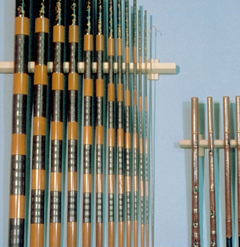EDO Wazao (Fishing Rods)

Edo fishing rods, which are made from bamboo stems, were first produced in Edo (Tokyo) in the middle of the Edo era (1600-1868), and had taken on their present-day form by the end of the era. Living near rivers and with the sea at their doorstep, residents of Edo who loved fishing benefitted from the research that went into these rods, which can truly be called works of art.
Edo fishing rods are extremely practical, each designed with a particular fish and particular set of circumstances in mind. Moreover, each rod can be made to accommodate the preferences of its owner. Once all these conditions have been satisfied, the rod is beautifully finished with a coat of natural lacquer.
Feature
Edo fishing rods are practical tools that differ according to the fish and place they are used for as well as the preferences of the owner. After being designed to accommodate these various conditions, the rods are beautifully lacquered.
How to make
Edo fishing rods are made primarily of Hoteitake, Hachiku, Yadake and Madake bamboo varieties. The quality of the rod is determined by the materials used. The selection of bamboo is so important that the craftsmen cut the bamboo themselves. From among thousands of bamboo stems, only a select few are fashioned into rods. After being aged for several years, the bamboo stems are dried and polished for use. Because Edo fishing rods are jointed, only the exact number of bamboo stems needed are prepared. The stems are lined up according to which joint they will be used for and are then jointed, bound together and lacquered.

